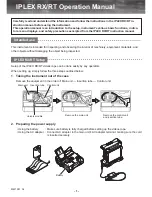
Manual instruction MM850482 ed.04
10
3.1.2
Water Trap & Line Filter
The gas flows through an external combined water trap and line filter to avoid the presence of condensation
and suspended solid particles in the analysis section of the instrument. A cylinder is positioned at 15 cm from
the instrument gas inlet it is divided into two parts: the water trap and the line filter.
The
water trap
works using the expansion principle: the gas flow decreases its speed inside the cylinder and
it will cool; the humidity will condense and the solid particles fall down. The section of the water trap must be
periodically drained off to avoid water from entering the analysis section. Pull the rubber plug (cat. EE650081)
and shake slowly the trap to drain the water. Push the rubber plug to close the trap hole.
The
line filter
is positioned after the water trap and before the electrochemical cell. Its function is to stop the
smallest solid particles before the analysis. Remember to change the filter (cat. EE650074) every time it is
dirty.
Line filter
cat. EE650074
Rubber plug
cat. EE650081
WARNING
T
HE WATER TRAP MUST BE KEPT IN VERTICAL POSITION DURING GAS SAMPLING
.
A
N INCORRECT POSITIONING OF THE
TRAP CAN ALLOW THE WATER TO ENTER INSIDE THE ANALIZER AND DAMAGE THE ELECTROCHEMICAL SENSORS
.
NEVER
MAKE ANY ANALYSIS WITHOUT THE DRAINING RUBBER PLUG
.
THE MEASUREMENTS WILL BE INCORRECT
.
W
HEN YOU FINISH THE ANALYSIS
,
REMEMBER TO DRAIN THE WATER TRAP
.
B
EFORE PUTTING THE GAS PROBE IN THE
CARRYING CASE
,
REMOVE THE CONDENSATE WATER FROM THE PROBE HOSE
.
T
HE LINE FILTER SHOULD BE REPLACED WHEN DIRTY
.
N
EVER MAKE ANY ANALYSIS WITHOUT LINE FILTER AND
/
OR WATER
TRAP
,
AS IT CAUSES AN IRREVERSIBLE DAMAGE TO THE ELECTROCHEMICAL SENSOR
.
3.1.3 Gas
Sensors
The analyzer uses long life sensors for O
2
and CO measurements. The gas sensors are electrochemical cells
composed by two electrodes (anode and cathode) and an electrolyte solution. The sampled gas goes trough a
selective diffusion membrane. The oxidation process produces an output electrical signal proportional to the
gas concentration. The signal is evaluated by the electronics, converted to digital, processed by the
microprocessor, displayed and printed with a 0.1% volume resolution.
The flue gas must not be at a pressure that could damage or destroy the sensor. Measurements are always
carried out under "pressureless" conditions. The maximum permissible excess/reduced pressure is ±100
mbar.
Each sensor has a different response time:
O
2
= 20s to 90% of reading
CO (H
2
comp.) = 50s to 90% of reading
CO
= 50s to 90% of reading











































